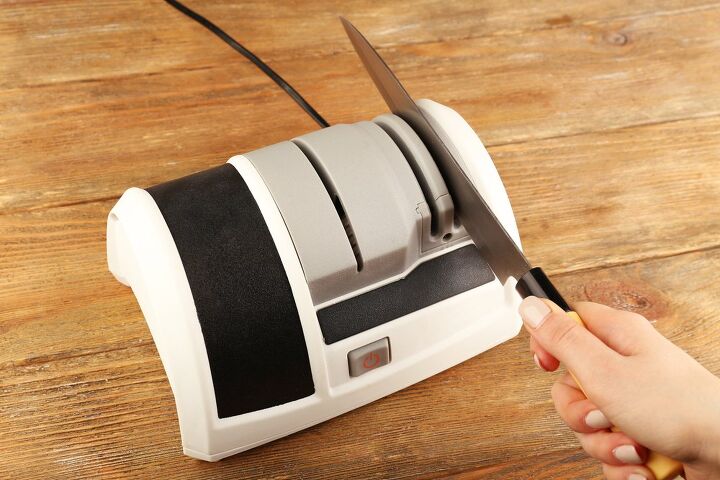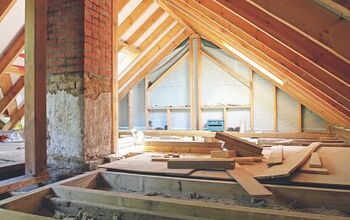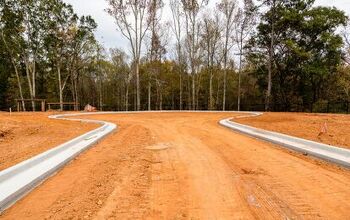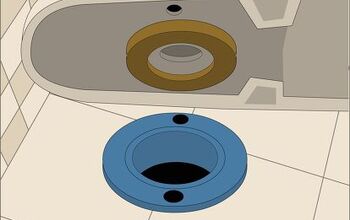6 Types Of Knife Sharpeners (With Photos)

There are a number of tools out there that are used to maintain and create a sharp edge on knife blades. Whether you’re shopping for your home or commercial kitchen, understanding what type of knife sharpener is best can spell the difference between your knife collection lasting only a year or for many years to come. After all, if you’ve already invested a large sum of money in a quality knife set, you should know a thing or two about how to keep them sharp.
The various types of knife sharpeners include electric sharpeners, handheld sharpeners, sharpening stones, honing steel, knife sharpening systems, and serrated knife sharpeners. The first three options are designed to create a new edge on a knife blade, while honing steel are mainly used to maintain a blade’s sharpness.
With so many different types of knife sharpeners out there, it can be difficult to determine which tool suits your situation and experience level. Our comprehensive guide will help you make an informed decision, so that you can keep your knives sharp and your kitchen running as safe and efficiently as possible.
Knife Sharpening Terms
Before we dive right into kitchen knife sharpeners, there are several terms that you should be familiar with. These include:
- Bevel: Also called grind, the bevel refers to the shape of the blade edge.
- Edge: The sharpened, or base, of the blade.
- Grit: How large or small the abrasive material is on a sharpening stone. Generally speaking, the lower the grit number, the rougher the stone and vice versa.
- Honing: Describes the act of maintaining the sharpness of a blade that is already sharp.
- Sharpening: Refers to the process of physically removing metal pieces from a knife to form a new, sharp edge.
- Spine: The top section of the knife blade.
- Swarf: The tiny, metal particles that result from sharpening a knife blade.
Types of Knife Sharpeners
The five main types of knife sharpeners include electric, handheld, sharpening stones, steels, and sharpening systems. Serrated knives, on the other hand, can be challenging to sharpen due to the shape of their blade. For this reason, there are specific sharpeners designed to accommodate these types of knives.
Let’s take a look at each of these types in detail, along with their pros, cons, and what knives and situations that are best suited to.
1. Electric Sharpeners
Of all the types of knife sharpeners, electric sharpeners are the simplest devices to use. They require very little effort to operate and are very easy to use. Most electric knife sharpeners feature a two or three step process, which creates, sharpens, and hones the edge of the blade. These sharpeners have two or three slots, with spinning sharpening stones inside that grind and sharpen the blade as you pull it through.
Each slot has a different level of grit that allow you to fine-tune the edge. Generally, the first slot has the coarsest grit to sharpen a dull blade and the last slot has a fine grit to hone a sharp blade. A quality electric knife sharpener will come with a guide to ensure that you put the knife in at the proper angle, as angles are so important when sharpening knife blades.
The major advantage of electric sharpeners is that they exponentially simplify the process of sharpening knives. While they require little to no skill, it’s important to keep in mind that electric sharpeners grind away more of the edge each time that you use them. As the device takes off more metal than is necessary, it may be shortening the life of your knife in the process.
2. Handheld Sharpeners
Like electric sharpeners, handheld sharpeners help simplify the entire sharpening process. However, since there is no spinning motion and they usually have fewer slots for sharpening, the process is a bit slower. You can find handheld sharpeners with slots that you pull the knife through and also those that involve you pulling the sharpener over the blade. Both types can effortlessly sharpen a dull knife back to its ideal cutting form.
With a handheld sharpener, you are given more control over the sharpening than with electric models. Like electric sharpeners, they have pre-set angles which are convenient, but may require more physical effort. This type of sharpener is also portable and the manual operation makes it ideal for cooking professionals on the go. Or, if you’re limited on counter space, you can stash a handheld sharpener away when it’s not being used.
Overall, a handheld sharpener will yield an excellent, sharp edge on your knives, while also giving you better control than its electric counterpart.
3. Sharpening Stones
Also called whetstones, sharpening stones are one of the most common devices used for sharpening knives. However, while all sharpening stones are whetstones, not all whetstones are wet. The term “whet” simply means to sharpen and while some whetstones are used wet, there are others that require oil or are used completely dry.
To enjoy ultimate control, a sharpening stone is the way to go. Although using a sharpening stone is the oldest method, many claim that it is the best. The most common materials that sharpening stones are made out of are silicone carbide, aluminum oxide, and Novaculite – known as Crystolon, India, and Arkansas stones respectively. Both Crystolon and India stones are man-made, while Arkansas stones are natural stones.
- Crystolon stones: ideal for initial coarse knife sharpening.
- India stones: best suited for fine sharpening purposes.
- Arkansas stones: can vary from fine to coarse in terms of grit type.
The drawback to this method of sharpening is the steep learning curve. You’ll want to practice on your cheaper blades before you graduate to using a stone on your most expensive ones. Using a sharpening stone properly involves applying the proper pressure and knowing how to hold the knife at the right angle. Though once mastered, you can sharpen virtually any blade using a whetstone with maximum accuracy.
4. Sharpening/ Honing Steel
This product has many names, including honing steel, sharpening steel, honer, knife honer, hones, and more. Despite their name, most sharpening steel does not actually sharpen knife blades. Honing a knife means that you are realigning the key edge of the blade after it has been bent out of shape.
Most knife sets come with a hone, which looks like a long metal rod with a handle at the end. Under consistent use, a sharpened knife edge will get bent and ultimately lose its sharpness. After honing, the edge doesn’t technically become sharper, it’s just returned back to its original, straight form and will cut as if it has been sharpened.
To use a honing steel, you must run the blade along the hone at the correct angle. This will straighten the bent edge of the knife and is an excellent way to maintain it in between sharpenings. The more you hone, the less you’ll have to sharpen, which results in a longer lifespan for your knives.
Like sharpening stones, it can take some practice to get the hang of the process, including how to hold the knife at the right angle and how much pressure to apply. The main job of sharpening steel is to hone a knife blade, but there are certain cuts, or styles, that can perform minor sharpening. Regardless, these styles should still never be used in place of any of the other sharpeners on this list.
5. Knife Sharpening Systems
A knife sharpening system offers the best of both worlds when it comes to the convenience of electric models and the precision control of a sharpening stone. Instead of passing the knife across or through the sharpening surface, the knife remains fixed and the user moves the stone over the knife blade.
There are a number of different systems and each functions a little differently, but the principles are the same with each – the knife is secured in place on the device and the operator sharpens the knife using a whetstone that is attached to the device on an arm at a fixed angle. The angle can be adjusted based on the blade that’s being sharpened.
Some systems are only designed to sharpen one side at a time, while others allow you to do both without any shifting. Like honing steel and sharpening stones, there is a learning curve with this method. It is also slower and more labor-intensive than using an electric knife sharpener, or even a handheld. However, like anything, it’ll get easier and faster with practice.
6. Serrated Knife Sharpeners
Serrated knives are a unique beast that can be challenging to sharpen with a sharpening stone because of the shape of their blade. Also, both manual and electric sharpeners can actually cause damage to serrated knives. Fortunately, there are specific sharpeners designed for sharpening serrated knives. Always consult the specific details of the sharpener before buying.
In most cases, the manufacturer will state whether or not their sharpener is safe to use with a serrated blade. Look for this information in the product description.
Related Guides

Jessica considers herself a home improvement and design enthusiast. She grew up surrounded by constant home improvement projects and owes most of what she knows to helping her dad renovate her childhood home. Being a Los Angeles resident, Jessica spends a lot of her time looking for her next DIY project and sharing her love for home design.
More by Jessica Stone
































